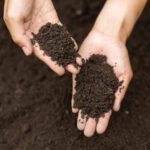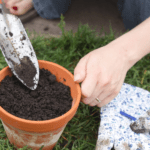Did you know that the average person spends around $50 on potting soil every year? It’s a significant investment, especially if you’re an avid gardener or plant enthusiast.
But have you ever wondered if potting soil can go bad? Can it lose its effectiveness over time and leave your plants struggling for nutrients?
We’re discussing whether this is a real concern or just a myth.
If you want to ensure the health and vitality of your plants, keep reading to learn the secrets of potting soil longevity.
What is Potting Soil Made Of?

Potting soil is like a secret recipe for plants, creating a magical environment that helps them flourish and thrive.
It’s a carefully crafted blend of materials that work together to provide optimal conditions for plant growth.
The key ingredients, such as peat moss, sand, perlite, pine bark, and vermiculite, serve a specific purpose in supporting plant roots.
Peat moss retains moisture, sand and perlite improve drainage, pine bark adds organic matter and provides good aeration, and vermiculite increases water retention.
These components ensure that plants receive the necessary air and water to develop strong roots and healthy foliage.
Unlike garden soil, potting soil is specially formulated for container plants, where aeration and drainage are crucial.
By using potting soil, you’re giving your plants the best chance at success.
Does Potting Soil Expire?
With time, potting soil may lose its effectiveness and require fresh ingredients to revive its vitality.
While potting soil does have a long shelf life, it can expire due to a variety of factors.
One major factor is the breakdown of organic matter in the soil, which can occur over time.
As the organic matter decomposes, it releases nutrients that plants need to thrive.
However, once these nutrients are depleted, the soil becomes less effective.
How to Tell if Potting Soil Has Gone Bad
If you’re wondering whether your soil has gone bad, there are a few key signs to look out for.
Presence of Pests and Insects
Beware of pests and insects lurking in your soil.
These unwanted visitors can wreak havoc on your plants by feasting on their precious roots.
One common pest that indicates your soil has gone bad is the fungus gnat.
The larvae of these tiny critters are drawn to decaying organic matter or fungi, which suggests that your soil is no longer suitable for use.
Fungus gnats can harm your plants by feeding on their roots, leading to stunted growth and even plant death.
To eliminate these pests, you should let the soil dry out which will kill the larvae.
Unpleasant Odor

When bacteria and fungi decompose organic matter in the soil, a foul, rotten egg-like smell can permeate the air.
This awful smell is a sign that your potting soil has gone bad.
To combat this issue, try the following two strategies:
- Aerate the soil: Introduce oxygen to the soil by spreading it out in the sun. This will help create an environment that is less favorable for the growth of odor-causing bacteria and fungi.
- Gently loosen the soil with a garden fork to facilitate better airflow.
- Rotate the soil periodically to expose all areas to sunlight.
- Replace the soil: If the stench persists despite aeration, it’s best to opt for fresh soil.
Mold Growth
When mold starts to grow, it’s time to say goodbye to your soil.
Mold growth in potting soil is a clear indication that the soil has gone bad.
Excessive moisture or extended periods of wetness can trigger mold formation. It is essential to address mold growth promptly.
By discarding the moldy soil and replacing it with fresh soil, you can prevent root rot and provide a healthy environment for your plants to thrive.
Dense Texture and Clumping
If your potting soil has a dense, clumpy texture that hinders the flow of water and air – it’s a sign that it may no longer be good.
When the peat moss in your soil begins to decompose, it can lead to the formation of clumps and a dense texture.
This is detrimental to your plants’ root development, as the compacted soil hinders drainage and aeration.
The Expiration Date of Potting Soil
If you’re wondering about the expiration date of potting soil, you might be surprised to learn that it’s not always a hard and fast rule.
Checking the expiration date can give you an idea of the shelf life of your soil, but it’s important to remember that it’s just a guideline.
The expiration date indicates the manufacturer’s estimation of when the soil may start to lose its quality.
However, if your potting soil has surpassed the expiration date and still appears to be in good condition, it may still be usable.
It’s crucial to pay attention to any signs of deterioration, such as mold, foul odor, or pests. If you notice any of these indicators, it’s best to play it safe and invest in fresh soil.
How to Revitalize Old Potting Soil
To revitalize old potting soil, add organic matter, improve drainage and aeration, and utilize worm castings.
Add Organic Matter
Boost the nutrient content and quality of your old soil by adding organic matter like compost or well-rotted manure – it’s a game-changer for healthy plant growth!
Organic matter acts as a rich source of essential nutrients, improving the overall fertility of the soil.
It also enhances the soil structure, allowing for better water and nutrient retention.
Improve Drainage and Aeration
Add perlite or vermiculite to your soil to create air pockets which will improve drainage and aeration.
These components prevent compaction and promote root health, ensuring that your plants receive the necessary oxygen and water for optimal growth.
Properly aerated soil allows plant roots to access nutrients more efficiently.
Utilize Worm Castings
Worm castings offer a potent source of nutrients for your plants.
They are rich in essential nutrients like nitrogen, phosphorus, and potassium, which are crucial for plant growth and development.
Not only do worm castings nourish your plants, but they also improve the soil structure and enhance its ability to retain moisture.
Extending the Life of Your Potting Soil
To ensure your soil stays fresh and effective, it is crucial to store it properly.
Use a secure container or trash bag with a tight-fitting lid.
Moisture is a common enemy of potting soil, as it can lead to the formation of mold and mildew, which can compromise the efficacy of the soil.
To prevent this, make sure that the unused portion of the soil is thoroughly dry before storage.
When storing unopened bags of soil, choose a cool and dark location.
Shield the soil from direct sunlight and extreme temperatures.
How to Test Your Potting Soil’s Quality
To ensure that your potting soil is of excellent quality and provides an ideal environment for your plants to thrive, test its quality.
Use the following three key indicators:
- Texture: Good potting soil should have a light and fluffy texture, allowing for proper aeration and water drainage. It should not feel too compact or sandy.
- Nutrient Content: High-quality potting soil should be rich in essential nutrients like nitrogen, phosphorus, and potassium. You can assess this by checking the soil’s packaging or conducting a soil test.
- Organic Matter: The presence of organic matter, such as decomposed plant material or worm castings, indicates healthy soil. This matter helps improve soil structure, water-holding capacity, and nutrient availability.
Conclusion
Potting soil does have a shelf life, but it can be extended with proper care and maintenance.
By regularly checking for signs of deterioration, you can know the quality of your soil.
Additionally, regularly testing the soil’s pH levels and nutrient content can help you determine if it needs revitalization.
Remember, taking care of your potting soil will lead to thriving plants and a successful garden.
FAQs
Can I use potting soil that has been stored for several years?
You can use potting soil stored for several years, but keep in mind that its effectiveness may decrease over time. Microorganisms break down organic matter, so it’s recommended to add fresh soil or compost.
Is it necessary to use fresh potting soil every time I plant?
It is not necessary to use fresh soil every time you plant, as long as the stored soil is free from contaminants and remains nutrient-rich. However, some gardeners prefer fresh soil.
Can I mix old and new potting soil together?
Yes, you can mix old and new soil together. This can help maintain a balanced nutrient profile and improve drainage. However, make sure the old soil is not contaminated with pests or diseases.
How often should I replace my potting soil?
You should replace your potting soil every 1-2 years. Over time, the organic matter in the soil breaks down, leading to nutrient depletion and decreased water retention. Regular replacement promotes healthy plants.







